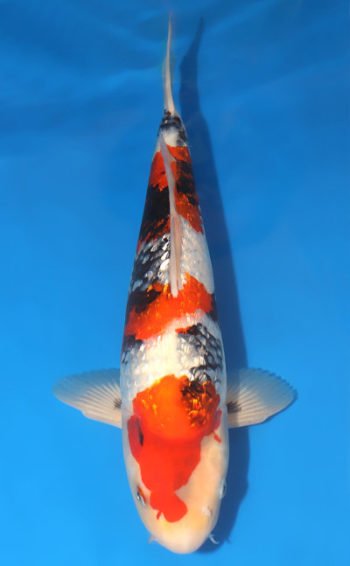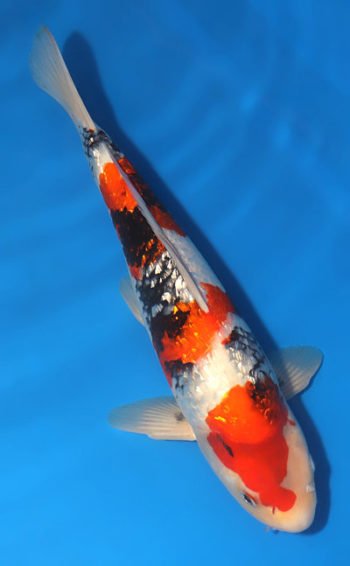Ginrin Showa Koi 14.96 inch
See all of our high-quality koi fish for sale & butterfly koi fish for sale. We offer the very best selection of koi for sale in the industry. Put that alongside of our incredible 14-Day Live Arrival Guarantee, and the ability to choose your own delivery date and you have an unbeatable value.
14-DAY WORRY-FREE GUARANTEE: We offer an industry-leading 14-Day Worry-Free Guarantee to ensure that you can shop with peace of mind, knowing that you will always be covered.
Breeder(s): Arowana Paradise Farm
Sex: Male
Size: 14.96 inch
Variety: Ginrin, Ginrin Showa, Showa
$160.00 $150.00
Description
Ginrin Showa Koi 14.96 inch For Sale
Ginrin Showa Koi 14.96 inch, Ginrin indicates the group of koi varieties that have diamond scales on the entire bodies. These scales are different from metallic and Platinum koi due to their scales being reflective and shining in the light in a miraculous way.
Kin-Gin-Rin (keen-geen-leen) is a reference to a koi’s scale type rather than the variety of koi, and literally means ‘golden silver reflective scales.’ Most generally, Kin Gin Rin is abbreviated to Gin Rin by koi breeders, sellers and koi hobbyists of today. Any koi variety can have Gin Rin scales, and what a brilliant enhancement the sparkly scales make. The addition of Gin Rin scales can transform an ordinarily plain koi into a stunning beauty. Gin Rin is highly reflective so that each scale glistens when it catches the light. It’s no wonder that koi are called Living Jewels.
The Gin Rin scales appear golden when they cover red pigment, or hi. A Gin Rin scale appears silvery when covering white or black pigment. Ideal Gin Rin scales should start at the base of the head, or shoulder, and continue to the base of the tail and along both sides of the dorsal fin. Rows of scales should be very neatly aligned with no random or mismatched scales. A koi needs to have at least 2 complete rows, preferably 3 or more, to be classified as Gin Rin for entering into any koi show. Symmetry is very important when evaluating Gin Rin.
Koi which fall into the Hikari Muji and Hikari Moyo classes (Ogons, Kikusui, Kujaku, Hariwake etc.) are shiny too, but theirs is very different from Gin Rin. Remember that Gin Rin is shiny scales. The Hikari classes are metallic, meaning that their skin has a metallic sheen or luster. That luster will cover the entire body, including the scales. Hikari varieties will show metallic luster on the head and fins with the pectorals being the most prominent. So, the difference between Gin Rin and Hikari Koi is scales versus skin.
What to Look For When Selecting a Gin Rin Koi
When searching for a good Gin Rin koi you need to look past all the bling, if that’s possible, and pick a fish that is as close to perfect in every other dimension. First, check out the koi’s body conformation. See that it has correct proportions and all fins are intact. Next, watch how it swims, breathes, and reacts to other koi. Then pick out the fish with the most pleasing pattern or colors that you like.
Finally you can concentrate on the Gin Rin scales. Remember that a Gin Rin Koi should have two or more complete rows of scales, the more the better. They should start at the shoulder and end at the tail. Look for scales that are neatly organized in straight and even rows. Avoid those with missing, random or jumbled scales. The layout or placement of scales will not change as your new pet grows. And lastly, choose the koi with the best sparkle as Kin Gin Rin koi are also judged on the quality of their scales.
Koi Care Guide – Six things to know about your koi
- Experience Level: Intermediate
- Size: Koi grow up to 36 inches (91 cm) long
- Lifespan: They can live for more than 50 years and thrive in a wide range of water temperatures
- Temperament: They are generally peaceful but may pick on slower fish
- Origin: They’re a type of carp native to Japan
- Did You Know: Koi can learn to recognize and take food from their pet parents
How do I set up my koi’s aquarium?
- Koi grow quickly and get very large. Keep mature koi in an outdoor pond of at least 3 feet deep, with at least 50 gallons of water per fish.
- Young koi can be kept indoors in an aquarium of at least 29 gallons.
- Put the aquarium in a quiet area out of direct sunlight and drafts.
- Cover the aquarium with a hood to reduce evaporation and splashing and to keep fish from leaping out.
- To transfer new koi to the aquarium, float them in the water inside their bag for about 10 minutes so they can acclimate to the new water temperature.
- If you’re introducing koi to an existing school in an aquarium or pond, quarantine the new fish in a separate body of water for 2 to 4 weeks to be sure they are healthy.
- On moving day, use a net to transfer the koi so old water doesn’t mingle with new water.
- Whether they live indoors or outdoors, add no more than 3 new koi at a time.
Heat & light
Outdoor koi are hardy and will hibernate under ice in winter as long as their pond is deep enough to not freeze completely. (They won’t survive in solid ice.)
Your koi’s pond should be partially shaded.
Indoor koi prefer water between 65 and 75 degrees Fahrenheit.
Install a light inside an indoor aquarium to illuminate it for 8 to 12 hours a day.
Water temperature
Koi are pretty temperature-resistant— they can even hibernate under ice in winter. Just be sure your pond is at least three feet deep— otherwise, it could freeze solid, and koi aren’t that tough. When they live indoors, koi prefer cool water—between 65 and 75 degrees F (18 to 24 C).
How do I keep my koi healthy?
If your outdoor koi don’t seem to be eating in the winter, don’t worry; it’s normal for them to stop eating at temperatures below 40 F. Be sure to contact a veterinarian if you notice any of these symptoms:
- Unusual swimming pattern
- Thinness or decreased appetite
- Abdominal swelling
- Inflamed or discolored skin or fins
- Fins clamped to sides of body
- Scraping body on rocks (flashing)
types of koi fish, koi fish tattoo, koi fish price, koi fish pond, koi fish meaning, koi fish for sale, koi fish drawing, koi fish care, koi fish for sale online, butterfly koi for sale, koi fish for sale near me, big koi for sale, buy koi fish cheap, koi fry for sale usa, types of koi fish, koi fish for sale, High Quality Koi, Search Live Koi, gin rin koi for sale, kin gin rin koi, pearl gin rin koi, doitsu koi, gin rin, butterfly koi, gin rin asagi, gin rin koi fish, gin rin chagoi





Reviews
There are no reviews yet.